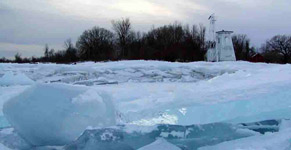Stay alive, stay ice smart

The Lifesaving Society encourages you to be ice smart - know the
basics and be sensible. Most winter drowning victims are male
snowmobilers. But everybody needs to be careful around frozen
lakes, rivers and streams. Year after year we hear of owners
drowning while trying to rescue their dogs (incidentally, the dogs
usually survive).
The Society's drowning data shows:
- Almost three quarters of ice-related incidents occur on lakes
(73%) and the rest occur on rivers.
- Most snowmobile incidents involve open water/ice holes (62% of
all snowmobiling incidents) or thin ice (38%).
Here's how you can be ice smart. First, understand the
importance of determining the quality and thickness of ice before
venturing onto it. No ice is without risk. Even thick ice may be
weak so be sure to measure clear hard ice in several places. The
quality and thickness of ice can change very quickly and its
appearance can be misleading.
There are several steps you can take to stay ice smart:
- keep away from unfamiliar paths or unknown ice,
- avoid travelling on ice at night - clear hard ice is the only
kind of ice recommended for travel,
- if you must venture onto the ice, wear a thermal protection
buoyant suit to increase your chances of survival if you fall
through. If you do not have one, wear a lifejacket/PFD over an
ordinary snowmobile suit or layered winter clothing,
- avoid slushy ice, thawed ice that has recently refrozen,
layered or rotten ice caused by sudden temperature changes, and ice
near moving water (i.e., rivers or currents),
- never go on the ice alone; a buddy may be able to rescue you or
go for help if you get into difficulty,
- before you leave shore, inform someone of your destination and
expected time of return, and, ideally,
- assemble a small personal safety kit no larger than the size of
a man's wallet to carry with you. The kit should include a lighter,
waterproof matches, magnesium fire starter, pocketknife, compass
and whistle. You should also carry ice picks, an ice staff, a rope
and a cellular phone.
Ice myths and cold realities
Be Water Smart® in summer, and winter! Always check the ice
before you go on it, measure clean hard ice in several places and
be wary of varying temperature conditions. Here are some myths and
realities to remember:
1) Myth: Waterlogged clothing pulls you down in
the water and makes you drown.
Reality: Actually, air trapped in your clothing will
help keep you afloat temporarily. Once the clothes are soaked with
water, they will be heavier, making moving and swimming more
difficult.
2) Myth: The better you swim the better your
chances of rescuing yourself if you fall through the ice.
Reality: Swimming proficiency plays only a small part
in ice-related rescues. After as little as five minutes, cold water
begins to rob you of your ability to move your limbs. This makes it
very difficult for you to get out of the water, no matter what your
swimming ability.
3) Myth: Snow on a frozen lake or river makes
the ice surface stronger.
Reality: Snow acts as an insulating blanket, actually
hindering ice formation and growth.
4) Myth: If the weather has been cold, the ice
must be solid and safe.
Reality: Other factors that are largely independent of
air temperature (e.g., wind, a layer of snow on the ice, currents
and fluctuating water levels) can weaken ice and make it unable to
bear weight. A sudden drop in air temperature, which is actually
more dangerous than a sudden rise, can create cracks in the
ice.
5) Myth: Thick ice is stronger than thin
ice.
Reality: Even thick ice may be weak if it is "rotten"
or contains layers of water. Rotten ice has frozen and thawed
repeatedly, making it potentially fragile even when it appears
solid.
Check the ice before you go on it.
Thin ice is responsible for many fatalities each year.
Hypothermia, which is a decrease in body temperature, kills people
in cold water by reducing their ability to swim or stay afloat. A
person who has fallen through the ice can eventually die of cardiac
arrest if he or she is not rescued or rewarmed.
Although most victims who fall through the ice are men, it is
important that safety tips are practiced by all.
Safety Tips:
- Always check ice thickness before venturing out. Snowmobiles
require at least five inches of clear solid ice and autos at least
eight inches to a foot of clear solid ice.
- Be suspicious. You cannot tell the strength of the ice by its
appearance. Temperature, thickness, snow cover, water depth, size
of water body, currents and distribution of the load on top of the
ice are all factors affecting ice safety.
- Before you head onto any ice, check with a local bait shop
operator or resort owner for known ice conditions, thin ice areas
or dangerous open water conditions.
:::
What to do if you break through the ice?
- Don't panic - the clothes you're wearing will trap air and keep
you buoyant.
- Turn toward the direction you came from and place your hands
and arms on the unbroken surface.
- Kick your feet and try to push yourself forward on top of the
unbroken ice on your stomach like a seal.
- Once you are lying on the ice, don't stand up. Roll away from
the break until you're on solid ice.